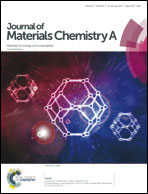Branched polyethylenimine grafted electrospun polyacrylonitrile fiber membrane: a novel and effective adsorbent for Cr(vi) remediation in wastewater†
Abstract
Cr(VI) is a well-known highly toxic metal ion and a thorough cleanup of this pollutant in wastewater is of special concern. Herein, a novel branched polyethylenimine (bPEI) grafted electrospun polyacrylonitrile (PAN) fiber membrane for Cr(VI) remediation based on adsorption was synthesized by a facile refluxing approach. Benefiting from the electrospinning process, the diameter of PAN fibers could be decreased to hundreds of nanometers from more than ten micrometers, which led to a higher adsorption capacity toward Cr(VI). In addition, the electrospun fibers showed good membrane forming properties, guaranteeing their application in the filtration purification process. Scanning electron microscopy (SEM), Fourier transform infrared spectroscopy (FT-IR), elemental analysis, contact angle and so forth were used to characterize the grafted fiber membranes. Different grafting ratios were achieved by varying the refluxing time to search for the optimized removal capacity toward Cr(VI). The adsorption properties of the grafted fiber membrane including batch adsorption and filtration adsorption were investigated. The results revealed that the bPEI grafted electrospun PAN fiber adsorbent possessed an excellent adsorption capacity toward Cr(VI) (qm = 637.46 mg g−1), which was higher than many other adsorbents. Moreover, the batch adsorption and dynamic filtration could also make the Cr(VI) concentration notably decrease from 10 or 5 mg L−1 to below 0.05 mg L−1, which is recommended as the drinking water standard by WHO. The obtained results suggested that the grafted electrospun fiber membrane could be potentially applied to the efficient removal of Cr(VI) in wastewater treatment.


 Please wait while we load your content...
Please wait while we load your content...